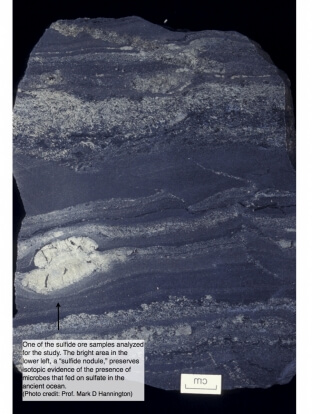Chemical analysis of lead sulfide deposits from mines containing the world's largest concentrations of the metal has confirmed the hypothesis that oxygen levels were extremely low on Earth 2.7 billion years ago.

Chemical analysis of lead sulfide deposits from mines containing the world's largest concentrations of the metal has confirmed the hypothesis that oxygen levels were extremely low on Earth 2.7 billion years ago. The analysis also showed that at that time bacteria in the oceans were actively feeding on sulfate while influencing the chemistry of the seawater.
The research, published by a team of scientists from Canada and the USA in the scientific journal Nature Geoscience, provides new insights regarding the use of ancient deposits of metal ores for a better understanding of the chemistry of the ancient oceans - as well as the initial development of life on Earth.
The sulfate ion is the second most abundant ion dissolved in the oceans today. It originates from the oxidation of rocks by atmospheric oxygen and is formed following chemical reactions of the oxygen with pyrite (known as "fools' gold") which is the mineral form of iron sulfide. The researchers, from Ottawa and McGill Universities in Canada, measured the concentration of sulfur in samples of large sulfur lead from a mine in Ontario, Canada, using a particularly sensitive instrument called a mass spectrometer. The concentration is determined by the amounts of the different isotopes of sulfur present in the sample, where the prevalence of the different isotopes indicates the amount of marine sulfate that was incorporated into the sulfide ore that was found at the bottom of the ancient oceans. Today, the ancient mineral is found on the surface of the earth, and is especially common in Canada, in the area known as "the Canadian shield".
The scientists discovered that the amount of sulfate assimilated in the ancient mineral, whose age is estimated to be about 2.7 billion years, is smaller than the amount in similar minerals found on the ocean floor today. From these measurements, the researchers were able to develop a computer model that determined the amount of sulfate that must have been present in the water of the ancient oceans. Their conclusion was: the sulfate levels were 350 times lower than those present in the oceans today. Although these levels of sulfate in the ancient oceans were extremely low, they still managed to support the existence of an active bacterial population that used sulfate to obtain energy from organic carbon.
"The lead sulphide deposits we tested are common on the planet, with most of them being in Canada and especially in the province of Quebec," says one of the researchers. "We now have a tool for locating the place and time when these bacteria became common globally." "Our increasing ability to understand these ancient environments, as well as our ability to examine samples with a very high level of precision and sensitivity, have opened the door for us to a greater understanding of the conditions under which life developed on Earth."
The news about the study

3 תגובות
So what was the percentage of oxygen?